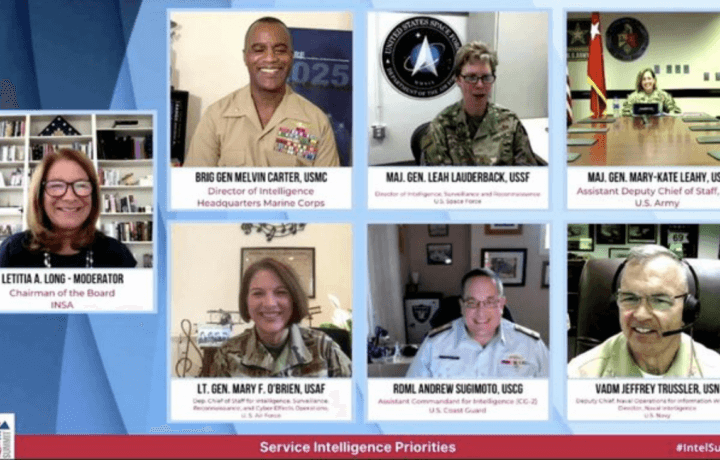Military service chiefs discussed their respective challenges and opportunities in a panel led by INSA Chairman of the Board, Letitia Long, during the second day of the Intelligence & National Security Summit. Focus areas included: intelligence support to service branches and joint priorities; intelligence readiness trends; critical skill sets and talent development; desired outcomes for space; and, private sector and Intelligence Community partnerships.
Lessons Learned From COVID-19
The panelists considered the effect COVID-19 has had on operations, the challenges, and what we can learn from this pandemic that will make the IC stronger moving forward.
Brig. Gen. Melvin Carter, USMC acknowledged that while it was a challenge to get things done operationally, family safety has been a priority and technical tools, like Microsoft, have been clutch in increasing communication in a distributed environment. Maj. Gen. Leah Lauderback, U.S. Space Force, echoed Carter, and she added that with standing up a command or service, like Space Force, they were already not working at full capacity, so, the pandemic has stifled progress at times. All panelists agreed that teleworking has helped offer some work-life balance. Including teleworking days moving forward is something that we can push into our organization.
“We have talked about bringing this component of work-life balance for years, but we’ve learned just how much we can do,” Maj. Gen. Kate Leahy, U.S. Army Assistant Deputy Chief of Staff, G2 agreed. “The pandemic did provide an opportunity to up the game on telework. We don’t have the option of hitting pause on work, but there are elements within the team that can work from home.”
Even post pandemic, the technologies that were rolled out as a response mechanism are going to be part of routine business, and will help support future continuity of operations. The increase in technology use can’t just end at the end of the pandemic, she noted.
Lt. Gen. Mary O’Brien, U.S. Air Force, implemented check-ins with coworkers in order to continuously improve capabilities. The remote classified work was already a potential capability, so COVID-19 provided the opportunity to fast-track that. O’Brien noted that the pandemic created telework believers who said “I always thought telework meant I can’t tell if you’re working.”
Rear Adm. Andrew Sugimoto, U.S. Coast Guard, commented on the fact that innovation was the single biggest component that became very important during the pandemic. People are the greatest resource in the intelligence community, so balancing family stress was a component to consider.
Vice Admiral Jeffrey Trussler, USN admitted that the Navy had a large transition to make, but with a good team already in place, it wasn’t as hard of a transition as expected. New hires and making transfers in the virtual world add a leadership challenge to the process. Leadership, training, and vigilance are crucial in maintaining national security with everyone distributed at home, he noted.
Remote classified work
With so much telework during COVID-19, the need for accessing the classified environment outside facilities shifted into high gear. O’Brien explained that the pilot was in the works, and some platforms were immediately ready to go to Pacific and headquarter staff.
“The tablets are working well, and there’s demand for more,” he noted. USAF is considering how to scale it out to what is needed, he added.
Additionally, O’Brien cited the need to look to industry to help across different solutions. Being mobile is an imperative for the 21st century warfighter.
Leahy agreed and stated that the pandemic was a targeted opportunity for this effort. She explained that the NSA program was effective on the CI and HUMINT platforms, and classified laptops and phones were given to senior leaders. She also pointed that Microsoft was a lifesaver to connect portions of workforce at home and in the Pentagon for unclassified work. Long term solutions are needed because this will be needed post pandemic.
Space Force
With Space Force now added to the mix, everyone wants to know how it is going. Space Force will have its first birthday on December 20. Lauderback explained that she is standing up headquarters at the Pentagon. She explained the need for Space Force to be lighter and leaner – with only about 15 people at headquarters, it will be a slow growth. Lauderback discussed the need to figure out what’s not being answered already and look for ways to answer those questions. Because of the distance of space and the domain itself, confirming decisions is challenging at times.
All panelists agreed that America’s adversaries are not resting, and we need threat-informed capabilities. With joint warfighting concepts being a requirement, Leahy confirmed the need to leverage all of the layers available with intelligence in order to paint the full picture for commanders. The Army has embarked on a campaign of learning with new systems combining capabilities together. Lauderback agreed, noting the massive amounts of data that have to be ingested and tracked. So sharing the data with other services can help increase domain awareness.
Arctic Circle: risks and opportunities
Trussler noted that with the ice slowly receding, the Arctic route is opening up more. While it’s still treacherous, it does provide an opportunity for cooperation for research and rescue. However, adversaries, like Russia, may have more opportunities opened up for them to establish dominance or insert themselves as leaders.
Diversity in the intelligence community
“Diversity builds better teams. We don’t have it all right, so it’s good to remember some of our shortcomings and challenges and to keep upping our game. It’s difficult to measure, but it’s still important to make it a priority to have diversity in thought, ” said Brig. Gen. Carter.
Trussler agreed, and explained that he has been more committed to listening for biases that others have experienced. The more awareness you have and experience with different people, the more well-rounded your views are, he added, with all panelists emphasizing that listening is key to building diversity in the IC.




